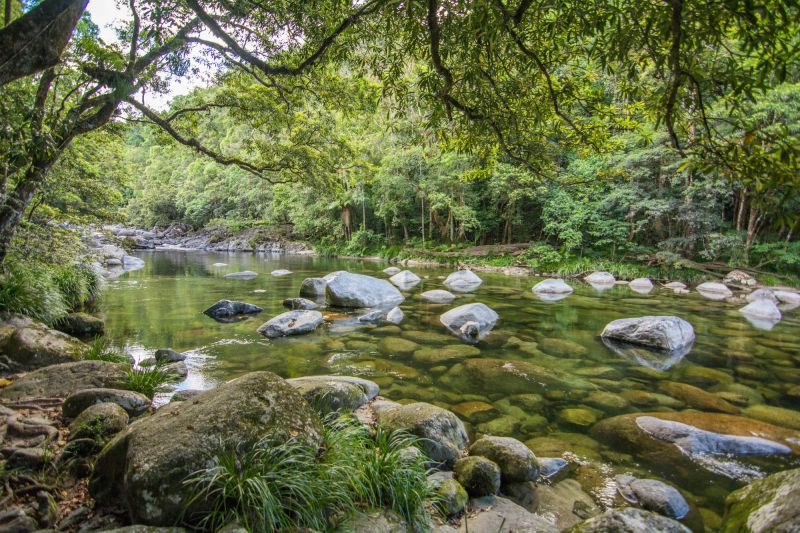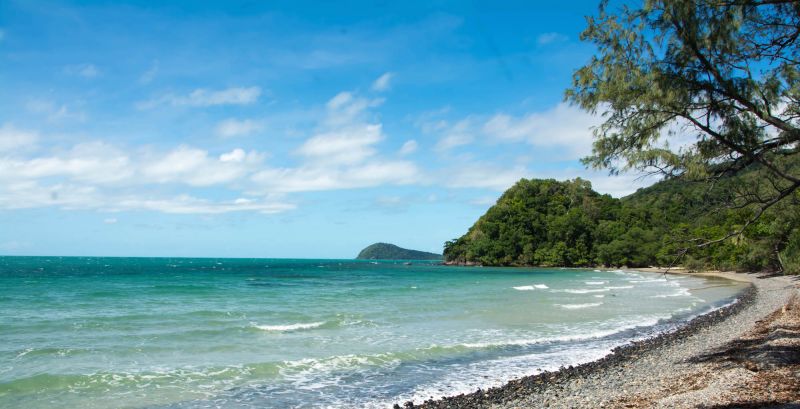Daintree National Park
The Daintree National Park represents the single largest mass of tropical rainforest in Australia, extending from the Daintree River to the Bloomfield River (70 kilometres or 43 miles); an area of approximately 1,200 square metres (463 square miles).
The Daintree Rainforest was given World Heritage status in 1988 and has the highest number of plant and animal species in the world that are rare, or threatened with extinction. It is one of the most complex ecosystems on the planet and the oldest continually surviving rainforest, estimated to be 180 million years old. This is tens of millions of years older than the Amazon Rainforest; a result of fortuitous continental drift after the breakup of Gondwana.
Unlike other areas of Australia that have became more arid over time, the topography and climate around the Daintree region provided the ideal conditions for the rainforests to continue to flourish without the need to adapt. A staggering 920 tree species can be found across the region, several which have only been discovered in recent decades. The Daintree is also famous for providing the earliest living examples of flowering plants, with 12 of the 19 primitive flowering plant families apparent.
This natural wonder is home to thousands of species including around one-third of Australia’s frog, reptile and marsupial species, around two-thirds of Australia’s bat and butterfly species, over 400 bird species and 12,000 insect species. Iconic species include the Boyds Forest Dragon, Saltwater Crocodile, Ulysses butterfly, Azure and Little Kingfisher, Wompoo Fruit Dove, Spectacled Flying Fox, Great-billed Heron, Spotted-whistling ducks and White-lipped Tree Frog.

Atherton Tablelands and Crater Lakes
The Atherton Tableland is part of the Great Dividing Range; a series of mountain ranges, plateaus and escarpments stretching 3,500 kilometres (2,175 mi) along Australia’s east coast. Around seven million years ago, vast amounts of lava flowed from several shield volcanoes over the Atherton Tableland, forming a dense layer of basalt once the lava cooled. The layers of basalt lava eventually turned into bright red soils as a result of weathering, creating highly fertile soil. Combined with significant rainfall and high temperatures, this has created the complex and diverse rainforests the regions is famous for.
Two significant landforms in the area are Lake Eacham and Lake Barrine, which were formed when rising lava was pushed against ground water, resulting in explosions from the heating of these underground streams. The resulting craters of Lakes Eacham and Lake Barrine were formed around 10,000 years ago and reach a depth of 65 metres. Over time, the surrounding rocks around the crater have sagged, creating larger lakes or in some cases, swamps. Bromfield Swamp is home to a population of Sarus Cranes, elegant long-legged water birds that look like a large heron. This area has one of the last breeding populations in the world.
A key attraction is the Cathedral Fig Tree, a gigantic 500 year old strangler tree, approximately 50 metres high with a trunk circumference of 39 metres and a canopy radius of 30 metres. There have been 120 birds recorded around this famous fig tree, including numerous songbirds.
There are twelve endemic bird species in the Tablelands area including the Atherton Scrubwren, Bower's Shrikethrush, Bridled Honeyeater, Golden Bowerbird, Pied Monarch, Tooth-billed Bowerbird and the Victoria's Riflebird. The rainforests provide habitat for the Platypus, Red-legged Pademelon, Musky Rat Kangaroo, Lumholtz Tree Kangaroo, Snapping Giant Eel, Eastern Water Dragon and Saw-shell Turtle.

Cape Tribulation
Cape Tribulation is a section of the Daintree National Park, representing Australia’s last range of lowland rainforest. This is the spot where two World Heritage Sites meet; the Wet Tropics Rainforest and the Great Barrier Reef. This provides a unique vista, being one of the rare locations where rainforest extends right to the shoreline (littoral or beachside rainforest), separated by beautiful white sandy beaches. The Eastern Kuku Yalanji people are the traditional custodians of the area, naming Cape Tribulation ‘Kurangee’ or ‘the place of many cassowaries’.
A geological feature along the shoreline are the bouncing stones at Thornton Beach, formed from an intrusion of granite that created the nearby coastal mountains. The giant granite boulders of Thornton Peak, form one of Queensland’s highest mountains, providing panoramic views of the sublime coastline and luscious rainforest. Aside from the opportunity to spot the endangered Southern Cassowary, the region provides the opportunity to spot the Bennett's Tree Kangaroo, Green Sea Turtles, Northern Long-nosed Bandicoot, Northern Bettong to name a few.

